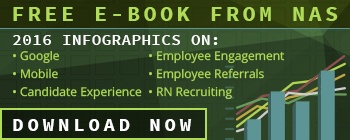-
The 2 most important analytics for HR professionals
Posted by Hannah Dumas on August 11th, 2016 
One of the hot-button topics in talent acquisition is the desire for analytics. HR leaders know that real data can help them make informed decisions, and that it will give them the support they need when building a budget, justifying their spend and determining how to create content for their site. There are two basic types of analytics that every HR professional needs to consider:
1. Tracking candidates from source to hire
Imagine being able to understand where the individuals who actually get hired by your organization are coming from. It’s the only way to really know what media is performing and where you should put your dollars. This is, by far, the most powerful metric available to you. When we bring up this topic, these are the responses we often hear:
“We don’t track this information at all.”
Then, you have no idea, aside from anecdotal evidence, where to spend your budget to get the best results. You are essentially making your media selection in a vacuum. Often, what you think is working the best is not. Analytics will open your eyes and allow you to make the right decisions. You might end up saving money that you can reallocate to other important efforts.
“We have a drop-down in our ATS where candidates indicate the source.”
Candidates are initially focused on one thing: filling out that application. They’ll bypass your drop-down or select the first one just to get past it. We know from experience that this information can prove unreliable at best, and misleading at worst. True candidate tracking is not voluntary; it is built into the code and just happens without the human factor.
“Our job board provides this information to us.”
Your vendor wants to ensure that you renew your contract and may present some highly selective results. In addition, you have to know what information they are actually giving you and how to interpret it. For instance, a report on clicks does not tell you whether the candidate took the next step and actually moved on and applied.
You need analytics you can trust – which means placing a tracking code on all online media, on your job feeds and on your site all the way through to hire, if possible, or application, if not. That way, you can compare results across media and make strong, informed decisions on how to allocate your resources – where to spend more, where to cut, etc. In addition, you can use an ad tracker or code for offline media, such as direct mail or print, to see what results you get from those efforts.
NAS offers an advanced analytics package with all of these capabilities, or you may be able to work with your own IT group to get proper tracking in place.
2. Tracking candidate behavior on your career site
We all agree that your career site is the ultimate portal for all candidates, right? You want to provide the content that these individuals are looking for, and the best way to do that is to understand what they’re currently looking at. Again, by placing tracking code on your career site, you can answer these questions:
- How much traffic are you getting, and what are the patterns?
- Are visitors local, regional or national?
- What browsers and operating systems are they using?
- What pages are they viewing on your site?
- How much time are candidates spending on each page?
- Do they return multiple times or visit just once?
- Are they viewing content before or after obtaining an interview?
- Are they engaging with your video content?
- Are they coming from desktop or mobile?
This information is very valuable. Some of it can tell you how to build your site (technical considerations about browsers, how much emphasis to put on mobile). The rest can help you decide what content to include. If a page is highly trafficked, you’ll want to emphasize it. If it gets few visitors, perhaps it can be removed. If there is drop-off after 30 seconds on your videos, make them shorter.
As you continue to track and review candidate behavior, you will be able to refine and update your site based on real knowledge, not just hunches or preferences. By being responsive to their needs and wants, you create a better candidate experience – and that’s what it is all about.
NAS would be happy to discuss analytics with you. Contact us today and we’ll be in touch.
Hannah Dumas




